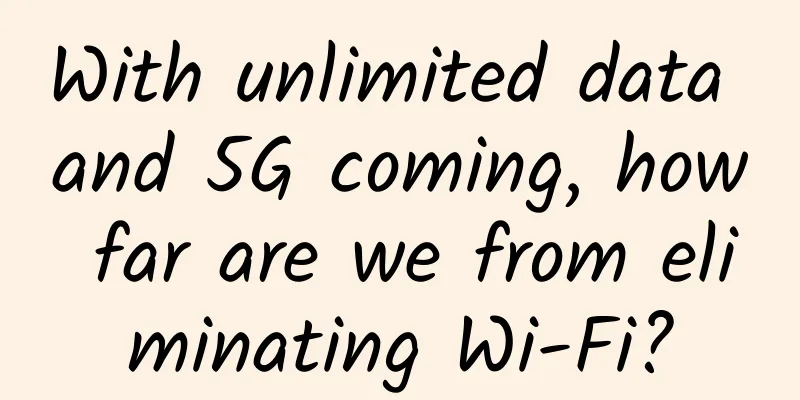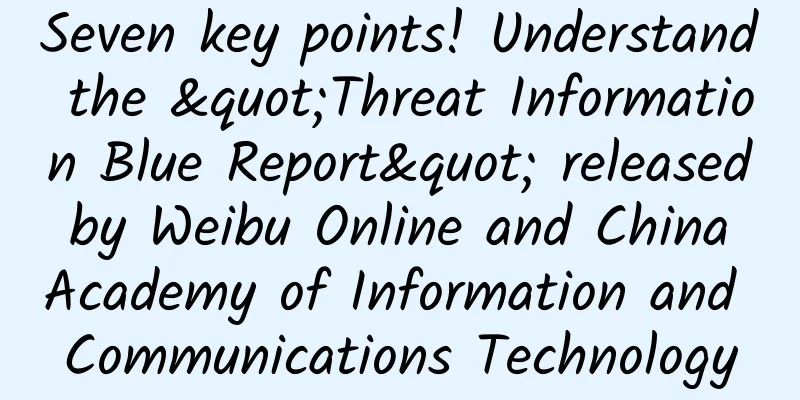With unlimited data and 5G coming, how far are we from eliminating Wi-Fi?

|
According to media reports, Wi-Fi may be phased out with the advent of the 5G era, pointing out that major US mobile operators currently provide 4G data traffic services, and consumers no longer need to turn on Wi-Fi networks to avoid expensive traffic fees. This may cause Wi-Fi to phase out. In addition, the emergence of some new technologies has also made the prospects of Wi-Fi bleak.
But in my opinion, despite the results of various factors such as new technologies, huge traffic and the 5G era in the future, there is still a long way to go before Wi-Fi is truly eliminated. We know that a few days ago, after the first and second largest telecom operators in the United States, Verizon and AT&T, announced in succession that they would provide users with "uncapped" traffic services, the four major operators in the United States have begun to launch unlimited traffic. The feeling of being useless behind the discount on domestic *** data traffic experience In China, the three major domestic operators launched "high-speed data" packages last year. However, the industry complained that there were generally tricks or discounted experiences in the high-speed data packages. The basic situation is this: For example, if you use more data than the package, your mobile Internet speed will drop to 2G mode, which is only 128Kbps at most. Although you can use it 24/7 without any additional charges, the speed of the data that exceeds the package is strictly limited, and the Internet experience is extremely poor. It is said that the Bangbo card launched by the telecommunications company has a fixed monthly fee of 46 yuan, which can enjoy 2GB of local 4G network speed traffic. After exceeding 2GB, local traffic can continue to be used for free, but the speed will be limited to 3.1MB at the highest speed and about 384K at the downstream speed. Earlier, China Unicom launched the Ice Cream Package for 398 yuan per month. China Unicom officials have stated that if the traffic exceeds 2GB on the day or 40GB in the month, the network speed will be limited to 384K at the highest speed at the downstream and 128K at the upstream speed. In addition to the speed limit, the "*** traffic" services launched by domestic operators are basically limited to local areas, and using them in other places will incur additional fees. Some operators even proposed that the "*** traffic" package service is only available to new users and cannot be used by old users. Therefore, it can be seen from here that the *** traffic service launched by the operator is not *** traffic in the true sense, but more like a castrated version. Basically, after exceeding the specified package traffic, it will be converted to a low-speed network, which will result in a poor user experience. Therefore, the so-called *** traffic is not *** in the true sense, but has many restrictions in terms of traffic limit, speed and region, which makes this castrated version of *** traffic full of tasteless. What are the reasons behind this? Why is it not realistic to say that mobile data will replace wifi? Why does this happen? On the one hand, the "*** traffic" launched by major operators has a good marketing effect of attracting new users. On the other hand, the current communication market is highly competitive and faces the general trend of increasing speed and reducing fees, and canceling roaming fees. By giving benefits to users through such low-cost packages, it can better win the hearts of the people. However, such packages are very watery, which is also due to problems in technology, cost and performance. Operators have begun to test the waters of 500M data packages, which has rekindled consumers' hopes for 500M data. However, the reason why 500M data is difficult to achieve is that wireless frequency resources are limited. Unlike fixed networks, wireless data transmission depends on bandwidth. The frequency resources of each of the three major operators are even more precious resources. At present, a base station can only bear a few hundred megabytes of traffic. The number of users who access each base station is also capped. If more users have preferential access, it will affect the Internet speed of all users. Therefore, the network quality of operators continues to decline as the number of users increases. As the demand for entertainment consumption is skyrocketing, the Internet speed of 4G networks is getting faster and faster, and the contradiction of frequency resources has become increasingly prominent. In the era of high-definition video and live broadcast, VR games, and short videos, the increase in the scale of *** traffic users will cause frequency resources to be occupied by a few people, and the traffic will instantly reach tens of megabytes or hundreds of megabytes. If the use of *** is excessively liberalized, the base station will not be able to bear it. Therefore, from this point of view, it is difficult to completely limit the flow. Therefore, the technical limitations and bottlenecks mean that the real *** flow package still needs to break the limitation of limited frequency resources, and there is still a long way to go in terms of technology. On the other hand, performance evaluation is the main factor. The introduction of *** traffic is likely to lead to an increase in the cost of operators, including the cost of adding modules to the billing system, and the need to continuously increase the construction of base stations to ensure high-quality services. After the construction of base stations, it is also necessary to spend increasing land occupation fees and subsequent maintenance fees. In addition, it is difficult to say whether the revenue from traffic will increase due to the excessive liberalization of *** traffic by operators, so performance will be affected. The impact on performance will cause operators to bear pressure from shareholders, investors and the State-owned Assets Supervision and Administration Commission. The State-owned Assets Supervision and Administration Commission's salary requirements for central enterprises are linked to the benefits they generate, and central enterprises also have the responsibility to maintain and increase the value of state-owned assets. If performance declines, they will obviously face many problems such as pressure from investors and shareholders, and the decline in the total salary of their own employees will affect the stability of the internal team. Therefore, we see that under the pressure of increasing network speed and reducing fees as well as canceling roaming charges, operators have other means besides offering high-speed data packages, which are basically strategies to save the country in a roundabout way. For example, large-data traffic cards are priced at more than 100 yuan and are mainly aimed at users who really have data needs. Currently, among the four major operators in the United States, T-Mobile and Sprint also have unlimited packages, but they also have speed limits, prohibition of using wireless hotspots, and data function shutdown when reaching a certain traffic volume. Therefore, the claim that 100% data traffic services make WiFi irrelevant to mobile phones is not realistic at present. Will 5G really eliminate Wi-Fi? There is still a long way to go as the problems of tariff and technology remain to be solved. However, the 5G era is coming, and *** traffic may be a little different in the 5G era. According to industry estimates, 5G will begin commercial use worldwide in 2020. We know that the 5G era will be an era of the Internet of Everything. Smart cars, smart homes, VR, etc. will all use 5G networks to access the Internet. In addition, in order to improve performance, operators must also develop new businesses such as the Internet of Things, cloud, and big data, which are highly compatible with the 5G era. Once the 5G network is officially commercialized, it is expected to leverage the Internet of Things industry. Moreover, the Internet speed brought by 5G far exceeds the current 4G experience. It is said that the Internet speed of 5G can reach 10-100 times that of 4G, and it can transmit 8K resolution 3D video in real time, or download a 3D movie in 6 seconds. But the problem is that the commercial use of 5G in 2020 is only a prediction. It does not mean that 5G will cover the entire country seamlessly. It requires a relatively long construction period to gradually and slowly replace the coverage. According to the law, the existing 4G LTE will continue to evolve and become an important part of the 5G platform. Moreover, after 5G is commercialized, 4G, 3G, and 2G networks will continue to work. Regarding the 5G speed mentioned by Bloomberg, it will not only improve network speed, but also reduce traffic fees and force Wi-Fi to exit the stage. This is more of an ideal situation. As mentioned earlier, the performance evaluation issue of operational transformation is an important time node for operators to increase traffic charges in order to improve performance. Therefore, for 5G users' traffic package charges and large-bandwidth traffic consumption, the 5G era is more likely to bring about additional power consumption and a surge in charges. Many users currently have expressed concerns about traffic charges in the 5G era. In addition, the market will also face a series of problems such as additional power consumption caused by the performance improvement of terminals that support 5G and how to achieve multi-antenna design in a limited space. In addition, it is still difficult to say whether the 5G era can break through the technical bottleneck of scarce wireless frequencies, which means that it is still doubtful whether *** traffic will become a reality in the 5G era. Therefore, if the 5G tariff increases dramatically, it is obvious that more traffic demand may be diverted to the Wi-Fi network. Since 2009, China Mobile has invested heavily in building millions of Wi-Fi hotspots across the country. The launch of these Wi-Fi hotspots has indeed played an important role in diverting traffic from mobile data networks. In some office buildings or homes where there is no mobile phone signal or the mobile phone signal is unstable, Wi-Fi is still needed to supplement. Therefore, in the 5G era, users still need to do some things that consume traffic, such as downloading videos, in a Wi-Fi environment as much as possible to save higher traffic tariffs. In addition, Bloomberg believes that a new system called "LTE-U" (LTE in Unlicensed Spectrum) uses unlicensed spectrum to increase available network traffic for cellular data communications, which is a technical solution for deploying LTE on the WiFi band. It is a technical factor to replace WiFi. But in fact, there is still widespread controversy in the industry about whether LTE and Wi-Fi can coexist in unlicensed frequency bands. Alcatel-Lucent, Ericsson, Qualcomm and other companies believe that deploying LTE on Wi-Fi frequency bands will have little impact on Wi-Fi signals, but Google, Microsoft and others believe that there will be a greater impact. In 2015, Google wrote to the FCC, saying that there are potential risks in LTE and Wi-Fi sharing 5G frequency bands. In the same year, Microsoft also expressed similar concerns. Therefore, the technical solution of deploying LTE on the Wi-Fi frequency band still has many unclear technical difficulties and potential risks. So, from the current perspective, from the tricks of maximizing traffic, the interest game and performance improvement problems of operators, the problem of breaking through the technical bottleneck of scarce wireless frequencies, and the high charges that 5G may generate, coupled with the unclear technical risks of the technical solution of deploying LTE on the Wi-Fi frequency band and the many coexisting problems that will arise in the transition from 4G to 5G, it is not realistic to say that Wi-Fi will exit the stage of history. The current mobile network cannot truly maximize traffic. Therefore, judging from the current situation, Wi-Fi cannot be eliminated at present or even in the next few years, and the arrival of this time point may be a bit far away. Author: Wang Xinxi, senior TMT commentator. Reprinting of this article is prohibited without my permission. My WeChat public account: Redianweiping |
<<: Service assurance cases in carrier SDN
Recommend
Diagram: 5G millimeter wave peak rate calculation
[[390044]] This article is reprinted from the WeC...
The three major operators’ annual data for 2021 were released. How is their performance?
In a blink of an eye, the Spring Festival holiday...
10gbiz 40% off on all VPS hosts, Hong Kong CN2 GIA/Los Angeles CN2 GIA lines available
10gbiz's promotion is still going on, with 40...
National Bureau of Statistics: The number of 5G terminal connections in my country has exceeded 200 million
At present, my country's 5G development is ac...
Feiyuxing Wireless helps Wuhan Tilisaer complete panoramic coverage of office buildings
When it comes to staying beautiful, this is proba...
China 5G: I have 1G more than 4G, why do so many people still dislike me?
Introduction After the rapid development of 1G, 2...
RAKsmart Hong Kong VPS simple test, three network direct connection/Telecom CN2
A few days ago, we shared information about RAKsm...
Does Snowflake's popularity mean Hadoop is dead? What exactly is a big data system?
Any technology will go through a process from hig...
Ministry of Industry and Information Technology: Cancellation of data "roaming" fees will be implemented as scheduled in 2018
The State Council executive meeting on April 4 cl...
Firmly oppose! The Ministry of Foreign Affairs responded to the US revoking the operator's operating authorization in the US
[[388612]] On March 19, at the regular press conf...
Samsung, Qualcomm, Huawei, and Nokia, who are the world's top players in 5G technology?
Who are the top players in 5G? A report from rese...
[Black Friday] Anynode: $8/year KVM-512MB/10G SSD/1TB/Las Vegas
Anynode released a Black Friday discount plan, of...
How to implement RBAC with API Gateway and OPA
Currently, in order to ensure that the right peop...
How does the gateway record request response logs in SpringCloud microservices?
Hello everyone, I am Piaomiao. In microservices d...
my country will start deploying and building IPv6 address projects in 2017
[[181003]] A reporter from the Economic Informati...









